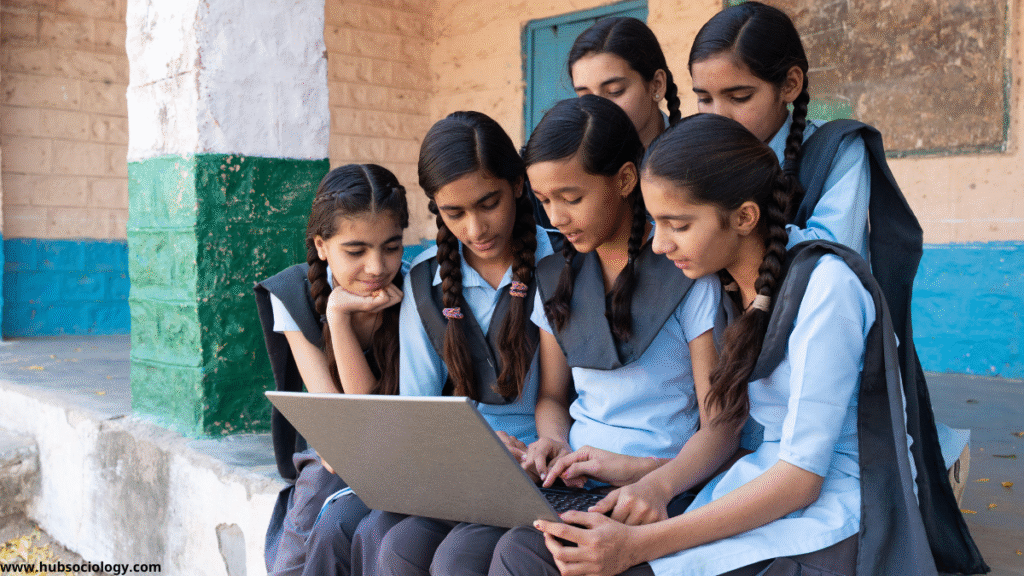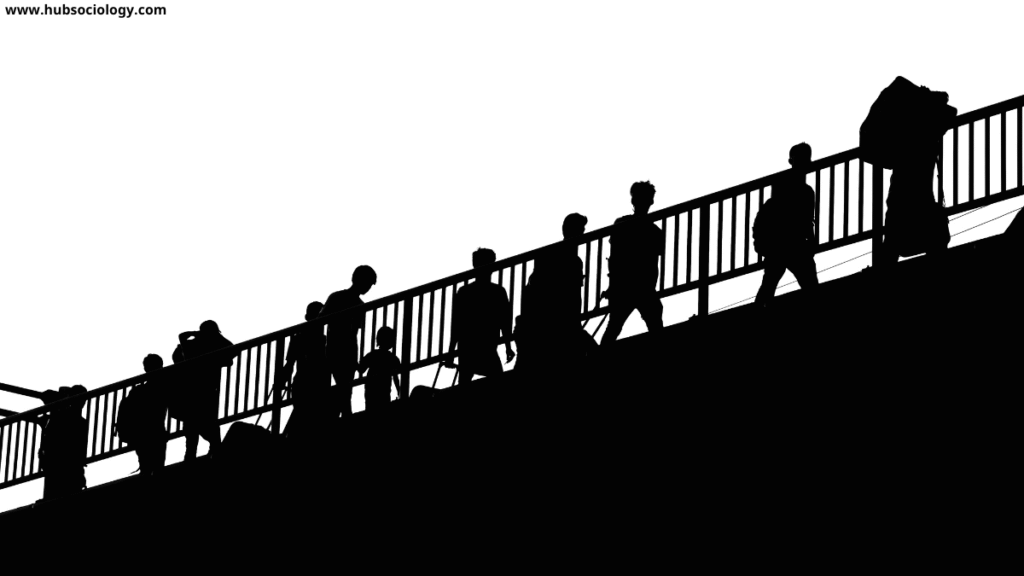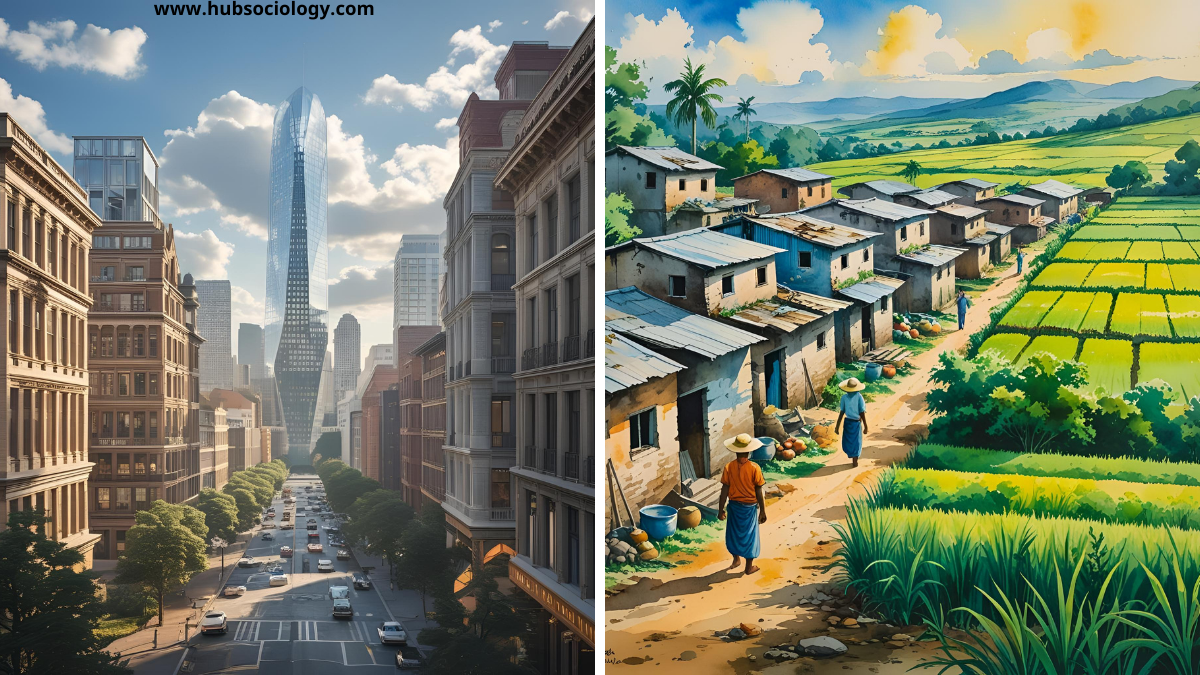Introduction
India, a country of immense diversity, exhibits a stark contrast between its rural and urban landscapes. The rural-urban divide is one of the most significant sociological phenomena shaping Indian society, influencing economic opportunities, social structures, cultural practices, and political dynamics. This divide is not merely geographical but encompasses disparities in infrastructure, education, healthcare, employment, and lifestyle.
From a sociological standpoint, the rural-urban divide reflects deeper structural inequalities rooted in historical, economic, and policy-related factors. While urbanization has accelerated with globalization and economic reforms, rural India continues to grapple with agrarian distress, limited access to resources, and social conservatism. This article examines the rural-urban divide in India through a sociological lens, analyzing its causes, manifestations, and implications for social cohesion and development.
Historical Context of the Rural-Urban Divide
The rural-urban divide in India has historical roots tracing back to colonial rule. The British administration prioritized urban centers for trade, administration, and infrastructure development, while rural areas remained neglected, serving primarily as sources of raw materials and revenue. Post-independence, India adopted a mixed economy model, but policy biases persisted.
The Green Revolution (1960s-70s) brought agricultural advancements but also widened disparities. Regions with better irrigation and infrastructure prospered, while others lagged, reinforcing economic inequality. Industrialization and liberalization (post-1991) further accelerated urban growth, creating a migration wave from villages to cities in search of better livelihoods. However, urban development was uneven, leading to overcrowded cities with inadequate housing and sanitation, while rural areas faced depopulation and declining agrarian economies.
Economic Disparities Between Rural and Urban India
1. Employment and Income Inequality
Rural India remains predominantly agrarian, with nearly 58% of the population dependent on agriculture (as per NSSO 2019-20), contributing only about 18% to GDP. In contrast, urban India thrives on industries, services, and technology-driven sectors, offering higher wages and diverse employment opportunities.

- Rural Employment: Dominated by informal, seasonal, and low-paying jobs in farming, daily wage labor, and small-scale enterprises.
- Urban Employment: Formal sector jobs in IT, finance, manufacturing, and services provide stability and upward mobility.
The income gap is evident—urban per capita income is nearly 2.5 times higher than rural (Economic Survey 2022-23). This disparity fuels migration, but many rural migrants end up in urban informal sectors with precarious living conditions.
2. Access to Markets and Financial Resources
Urban centers have better access to banking, credit facilities, and markets, facilitating entrepreneurship and investment. Rural areas suffer from:
- Limited banking penetration.
- Dependence on informal moneylenders with high interest rates.
- Poor market linkages for agricultural produce, leading to exploitation by middlemen.
Government schemes like MGNREGA and Kisan Credit Cards aim to bridge this gap, but implementation challenges persist.
Social and Cultural Differences
1. Education and Literacy
Urban areas boast better educational infrastructure—prestigious schools, colleges, and coaching centers—while rural schools often lack qualified teachers, electricity, and proper classrooms.
- Literacy Rate (Census 2011):
- Urban: 84.1%
- Rural: 68.9%
- Higher Education: Urban youth have greater access to universities and professional courses, whereas rural students face financial and logistical barriers.
This educational divide perpetuates occupational segregation, with rural youth often confined to low-skilled jobs.

2. Healthcare Disparities
Urban India has multispecialty hospitals, advanced medical technologies, and better healthcare accessibility. Rural healthcare suffers from:
- Shortage of doctors and primary health centers.
- High maternal and infant mortality rates.
- Dependence on traditional medicine due to lack of facilities.
Schemes like Ayushman Bharat aim to provide health insurance, but rural healthcare remains underfunded.
3. Cultural Norms and Social Mobility
- Rural Society: More conservative, with rigid caste hierarchies, patriarchal norms, and limited exposure to progressive ideas. Social interactions are closely knit, with strong community bonds.
- Urban Society: More cosmopolitan, with greater individualism, nuclear families, and exposure to global cultures. Caste identities are less pronounced in professional spaces, though discrimination persists subtly.
Urbanization has led to cultural hybridization, but rural areas often resist rapid social changes, creating a clash between tradition and modernity.
Infrastructure and Quality of Life
1. Basic Amenities
- Electricity: Nearly 99% urban households have electricity, compared to 88% in rural areas (NSO 2020).
- Sanitation: Urban sanitation coverage is higher, though slums remain a challenge. Rural open defecation has reduced post-Swachh Bharat Mission, but water scarcity persists.
- Transport & Connectivity: Cities have metros, buses, and ride-hailing services; rural areas rely on inadequate public transport.
2. Digital Divide
- Internet Penetration (TRAI 2023):
- Urban: ~67%
- Rural: ~38%
This gap affects access to e-governance, online education, and digital payments, marginalizing rural populations in an increasingly tech-driven economy.
Political and Governance Challenges
1. Policy Implementation
Urban-centric policies often neglect rural needs. For instance:
- Farm Laws 2020 protests highlighted rural distrust in urban-biased economic reforms.
- Smart Cities Mission focuses on urban development, while rural schemes like BharatNet (digital connectivity) face delays.
2. Political Representation
Rural voters dominate electoral politics due to higher population density, yet urban issues like pollution and housing shortages receive less attention. Panchayati Raj institutions empower rural governance but are often plagued by corruption and caste politics.
Migration and Its Sociological Impact
Rural-urban migration is a survival strategy for many, but it creates dual challenges:
- For Rural Areas: Brain drain—educated youth leave, weakening local development.
- For Urban Areas: Overcrowding, slum proliferation, and strain on resources.
Migrants face identity crises, discrimination (e.g., “outsider” stigma), and precarious living conditions in cities. The COVID-19 pandemic exposed their vulnerabilities when millions of migrants walked back to villages due to job losses.

Bridging the Divide: Possible Solutions
- Decentralized Development: Strengthening rural infrastructure (roads, electricity, digital networks) to reduce migration pressure.
- Agricultural Reforms: Better MSP implementation, agro-based industries, and farmer producer organizations (FPOs).
- Education & Healthcare: Expanding rural schools with digital learning and mobile health units.
- Urban-Rural Linkages: Promoting rural tourism, handicraft markets, and telemedicine to integrate economies.
- Policy Reforms: Inclusive urbanization with affordable housing and social security for migrants.
Conclusion
The rural-urban divide in India is a complex sociological issue shaped by historical neglect, economic policies, and governance failures. While urbanization is inevitable, equitable development must ensure that rural India is not left behind. Bridging this gap requires holistic policies, grassroots empowerment, and inclusive growth strategies. A balanced approach will not only reduce disparities but also strengthen India’s social fabric, ensuring sustainable progress for all.
As India aspires to become a $5 trillion economy, addressing the rural-urban divide is not just an economic imperative but a moral one—ensuring that development reaches the last mile.
Do you like this this Article ? You Can follow as on :-
Facebook – https://www.facebook.com/hubsociology
Whatsapp Channel – https://whatsapp.com/channel/0029Vb6D8vGKWEKpJpu5QP0O
Gmail – hubsociology@gmail.com
Highly Recommended Books
- Rural Sociology in India” – A.R. Desai – Amazon Link – https://amzn.to/4ly6kLL
- “Urban Sociology in India” – M.S.A. Rao
Topic Related Questions
5-Mark Questions (Short Answer Type)
- Define the rural-urban divide in the Indian context.
- What are the main causes of rural-urban migration in India?
- How does the caste system operate differently in rural and urban India?
- List three major economic disparities between rural and urban India.
- What role does education play in deepening the rural-urban divide?
- Explain the concept of ‘digital divide’ between rural and urban India.
- How does healthcare accessibility differ in rural and urban areas?
- What is the impact of rural-urban migration on Indian cities?
- Name two government schemes aimed at reducing the rural-urban gap.
- How does globalization affect rural and urban societies differently?
10-Mark Questions (Descriptive Answer Type)
- Discuss the historical roots of the rural-urban divide in India.
- Analyze the impact of economic liberalization (1991 reforms) on rural and urban India.
- How does the rural-urban divide affect gender roles in Indian society?
- Examine the role of education in perpetuating or reducing rural-urban inequalities.
- Compare the political representation and governance challenges in rural and urban India.
- What are the social and cultural differences between rural and urban lifestyles in India?
- Discuss the challenges faced by rural migrants in urban areas.
- How does infrastructure disparity contribute to the rural-urban divide?
- Critically evaluate government policies aimed at bridging the rural-urban gap.
- Explain how agrarian distress influences rural-to-urban migration.
15-Mark Questions (Long Answer/Essay Type)
- “The rural-urban divide in India is not just economic but also deeply sociological.” Discuss.
- Analyze the impact of the Green Revolution on rural-urban disparities in India.
- How does caste interact with rural and urban labor markets in India?
- “Urbanization in India has been exclusionary rather than inclusive.” Critically examine.
- Discuss the role of technology and digitalization in reducing (or widening) the rural-urban divide.
- “The rural-urban divide perpetuates social inequality in India.” Substantiate with examples.
- How does rural-urban migration affect family structures in India?
- Examine the challenges of implementing welfare schemes in rural vs. urban India.
- “The rural-urban divide is a major obstacle to India’s development.” Critically evaluate.
- Suggest policy measures to reduce the rural-urban gap in India with sociological insights.
Additional Higher-Order Thinking Questions (Case Study/Applied Sociology)
- Case Study: A village in Bihar faces mass migration to Delhi. Analyze the push and pull factors from a sociological perspective.
- How do films and media portray the rural-urban divide in India? Give examples.
- Compare the rural-urban divide in India with that of another developing country (e.g., China or Brazil).
- How do social movements (e.g., farmers’ protests) reflect the rural-urban conflict in India?
- “The Smart Cities Mission neglects rural development.” Do you agree? Justify.

1 thought on “Rural-Urban Divide in Indian Society: A Sociological Perspective”